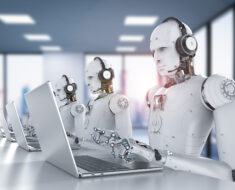In 2017, Quartz published a dramatic, hand-wringing article warning that up to 47 percent of all workers in the Western World were facing the risk of being laid off within 20 years. Their projected replacements were robots with artificial intelligence (A.I.). The article further stated that the vast majority of blue-collar jobs would be eliminated. However, just a mere year later, experts are singing a very different tune about the future of blue-collar employment. Instead of leading to our doom, A.I. is actually poised to change the landscape of blue-collar work for the better.
How is A.I. Changing the Employment World?
If you fear A.I., the odds are high that you’re not aware how often you currently take advantage of it. As entrepreneur and investments expert Paul Mampilly recently pointed out, A.I. helps you find music and movies based on your interests, and it can also pick out a single criminal’s face from a crowd of 60,000 people. Therefore, A.I. is already prevalent, and yet the U.S. has seen a large increase in job creation this year. Clearly, there were some significant miscalculations behind all of the A.I. doomsday prophecies.
Why Have Opinions on A.I. Varied so Drastically?
There are always going to be naysayers about any new type of technology. Sometimes this is rooted in fear, but other times it can be linked to the more insidious practice of trying to devalue a competitor’s latest product. This can make it extremely difficult for most people to sort through all the chatter in search of a reputable resource.
Paul Mampilly’s expertise on investment and business-related matters has been featured by several well-known sources, including Reuters, Bloomberg TV, MSNBC, Hedge Fund Intelligence, Fox Business News, Kiplinger’s and Fox News. This is a man who foresaw Netflix’s bright future due to his extensive knowledge of technological advances, which led to investment gains of 634 percent. In other words, when Mampilly makes a prediction about technology or stocks, it’s wise to pay close attention.
The Fordham University alumni has focused closely on the link between A.I. and blue-collar jobs, especially on his Facebook page. Mampilly wrote on November 12, 2018, that blue-collar workers “don’t have to fear” artificial intelligence. “As much as technology will take over menial tasks,” he elaborated, “it will further employees’ capabilities, and consumer demand, even more so.”
What Are Other Experts Saying?
Paul Mampilly definitely doesn’t stand alone in his positive view of A.I. technology in the workplace. Recent posts by business experts on Entrepreneur and the Los Angeles Times have backed up his point of view. The general consensus is that fear-mongering articles about the rise of A.I. have been off the mark, but this doesn’t mean that the technology won’t change the way blue-collar jobs work.
A.I. Is a Natural Result of an Ever-Evolving Job Market
Every generation in the past 250 years has dealt with a constant influx of technological advances. Despite this, Entrepreneur reported that the average unemployment rate during the last 2.5 centuries has maintained a mostly steady variance between 5 and 10 percent. Throughout this time period, industries have come and gone, as have production methods, but the need for human workers has never been eliminated.
The Future of Blue-Collar Work
Per the Los Angeles Times, the future of blue-collar work will be based on four key human traits:
- Creativity
- Emotional and Social Intelligence
- Sensory Perception
- Complex Reasoning
Humans will work closely with A.I. in most manufacturing plants. The good news, aside from blue-collar work still existing, is that most people will no longer be engaged in highly repetitive actions. This type of labor may be easy to master, but it also increases the risk of health complications such as carpal tunnel syndrome. Instead, A.I. will handle these tasks, which will leave human workers free to do things that require their specialized knowledge and creativity.
There are already several examples of this type of work environment in place, including at least one Rolls Royce production facility. Technicians who oversee the work produced by A.I. make good money too, with annual salaries of up to $70,000.
A.I. and the Stock Market
It’s common for blue-collar workers to invest their 401(k) in a diversified stock portfolio. Without recent technological advances such as A.I., many of the companies that make up the average stock portfolio wouldn’t be doing nearly as well, if they even existed at all.
Amazon is a prime example; the online retail giant uses A.I. for everything from sending out automated product recommendation emails to shipping orders. This increases Amazon’s revenues and speeds up the shipping process, yet it hasn’t eliminated workers. Instead, new positions are continuously added to the company’s estimated workforce of 575,000. Amazon has also committed to increasing U.S. worker wages to ensure everyone makes at least $15 per hour.
Companies that embrace A.I. are likely to be rewarded from a stock market perspective. Paul Mampilly uses his in-depth knowledge of investments and technology to help people who aren’t stock market experts via his Winning Investor Daily newsletter. This empowers blue-color workers to target their 401(k)’s and other retirement accounts toward tech stocks that have a great chance of paying off. After all, Mampilly didn’t just foresee the rise of Netflix; he was also an early investor in Google’s initial public offering. As you can imagine, that choice paid off handsomely.
More and more, we are seeing #AI being developed and used for creative purposes – pretty cool! There are infinite possibilities with this #tech. https://t.co/Czyx7yPtoG
— Paul Mampilly (@MampillyGuru) November 21, 2018
Why Are People So Afraid of A.I.?
As previously mentioned, every working generation for at least 250 years has had to deal with rapid technological changes. Without fail, members of each generation have feared that these changes would put them out of work. It wouldn’t be fair to say that no one’s job has suffered as industries have changed, folded and been born anew. However, it’s also not fair to pretend that new jobs didn’t open up to fill in the gaps.
Attitudes often need to evolve with the times. Bill Gates famously issued dire warnings about A.I. in 2015, but now he’s a big supporter of the idea that A.I. can be “our friend” and will improve our lives.
A.I. Is an Economy Booster
Not only do blue-collar workers not need to fear A.I. but the entire nation would be well-served by embracing it. Even if you don’t personally see the impact A.I. is having on the economy, Paul Mampilly indicates that it’s adding $1.2 trillion in economic growth this year alone.
Keeping an eye on big technological achievements helped Paul Mampilly win an investment competition from the Templeton Foundation for his forward-thinking approach to investing. It also helped him launch the Profits Unlimited guide, along with the trading services True Momentum and Extreme Fortunes.
Mampilly believes in industry projections that forecast an annual economic boost of $3.9 trillion in just four years. With one of the top technological investors in the nation highly tuned into A.I.’s potential to greatly boost the economy and any related stocks, this seems like a really good time to look forward with less fear and more optimism for the future of all Americans, including blue-collar workers.
More Mampilly News
Paul Mampilly Encourages Investors To Focus On The Internet Of Things
Dil Bole Oberoi





